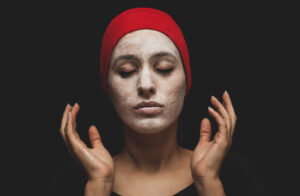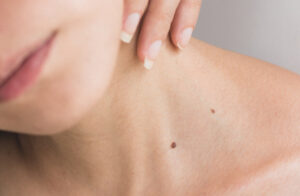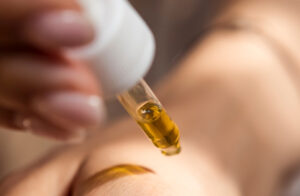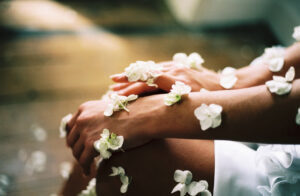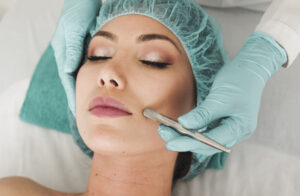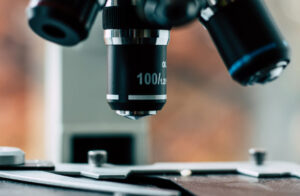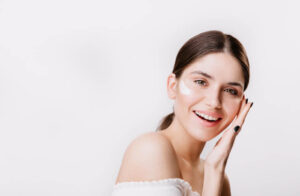Other Skin Conditions
See the full list of skin coditions we treat at North Idaho Dermatology.
Acne
Acne starts in the hair follicles of your skin with a substance called sebum. Sebum is an oily substance produced by the skin to keep it flexible and moisturized. Sometimes, this sebum can become thick and sticky. Sebum combines with dead skin cells to plug up your hair follicles. When these follicles are closed, you develop whiteheads. When they are open, you develop blackheads. These plugged-up pores are an ideal place for bacteria to grow. As the bacteria multiply and finally erupt out onto the surface of the skin, they cause swelling, redness, and pus; better known as pimples. These pimples can then become even more infected, causing deeper lumps, nodules, or cysts.
You should also know that your chances for developing acne are increased by hereditary conditions, such as larger than average pores, or overproduction of skin oils. One reason teenagers can get severe acne is that hormones c alled androgens, which are more active in your body during puberty, can also make the skin produce more oil. Menstruation also can bring on acne or make it worse. Finally, emotional stress, oil and grease from cosmetics, and medicines such as cortisone and barbiturates can work against your favor in dealing with acne.
Myth #1: Chocolate (or fried foods, or nuts or soda) cause acne. False!
The truth is, certain foods seem to make existing acne a little worse, but it has never been scientifically demonstrated that chocolate or fatty foods cause acne. So, go ahead, gulp down that double chocolate doughnut! (Just kidding!)
Myth #2: Acne can be passed from one person to another. False!
Although acne does involve bacterial infection, contact with the skin of someone who has acne will not infect you.
Myth #3: Acne is caused by dirty skin. False!
The cleanest skin in world can develop acne, and simply scrubbing your skin will not prevent acne. In fact, a cleansing regimen that is too aggressive may actually make acne worse.
Fortunately, we know a lot more about treating acne than we did just a generation ago. Treatment falls into two categories, the first of which might be called personal hygiene. Keeping your skin free of excess oil will go a long way toward minimizing your acne, so use oil-free cosmetics and sunscreens. Gently wash the affected areas of your skin twice a day with mild soap and warm water. The key word here is gently. Also, never squeeze pimples or blackheads; this can lead to longer lasting pimples. Avoid use of astringents on your face, which can strip your skin of its natural moisture. There are also very effective aesthetic peels and treatments that can greatly improve the look of skin with acne and aid in the healing process.
The second category is medical treatment, which includes regimens of medications that have been developed over the last few decades to treat acne. Examples of these include tetracycline, Benzamycin, and Accutane, all of which approach the management and treatment of acne in different ways.
Actinic Keratosis (AK)
Actinic keratoses, or “AKs” as dermatologists commonly call them, are scaly or crusty bumps that forms on the skin surface. Sometimes it is referred to as solar keratosis because it is caused by exposure to the sun. They can be very small or as large as a penny. They can vary in color, lightness, and other features. The scale or crust is dry, and rough, like a hoof, and is often recognized easier by touch rather than sight. Sometimes it itches or produces a pricking or tender sensation, especially after being in the sun. It may disappear for a time only to reappear later on. Avoiding exposure to the sun will help some AKs resolve (go away) on their own. AKs usually make their appearance on parts of the body that get lots of sun exposure and sun damage, like the face, ears, scalp, neck, backs of hands and forearms, and lips. AKs tend to lie flat against the skin of the head and neck but tend to be elevated on arms and hands.
Actinic keratosis is dangerous because it can be the first step in the development of skin cancer. For this reason AKs are often referred to as “pre-cancerous lesions” Some AKs continue to grow until they become skin cancers, usually squamous cell carcinomas.
Androgenic Alopecia (Common Baldness)
This type of baldness is a very common genetic disorder. The hair transitions from large, thick, colored hair to thinner, shorter, hair and finally to short, wispy, unpigmented hair in a gradual decline. In men an “M” shape begins to form as the hair recedes from the hairline. In women, a receding hairline is less common but a general thinning all over the scalp is more common.
Atopic Dermatitis
Also referred to as eczematous dermatitis, it is characterized by intense and chronic itching. This itching causes rashes, and is therefore very often first diagnosed in infancy. It can continue with the patient into adulthood. The disease often has an ebb and flow, getting worse or better for periods of time, which may be suddenly exacerbated by social, environmental, and biological triggers, much the same as the reaction in food allergies or bronchial asthma. Atopic Dermatitis is one of the most common forms of Eczema.
Basal Cell Carcinoma
Basal cell carcinoma, often referred to by the abbreviation, BCC is the most common form of skin cancer, as well as the most common of all cancers. It is almost always caused by chronic exposure to sunlight — especially sunburns — which is why the most frequently exposed parts of the body — the face, ears, neck, scalp, shoulders, and back, are the most affected. Rarely, however, tumors develop on non-exposed areas. People who have fair skin, blonde or red hair, and blue, green, or gray eyes are at highest risk.
There are 5 warning signs of BCC:
- a persistent, non-healing sore that bleeds, oozes, or crusts and remains open for several weeks;
- a reddish patch or irritated area;
- a shiny bump, or nodule, that is pearly or translucent and is often pink, red, or white. The bump can also be tan, black, or brown, especially in dark-haired people, and can be confused with a mole;
- a pink growth with a slightly elevated rolled border and a crusted indentation in the center. As the growth slowly enlarges, tiny blood vessels may develop on the surface;
- a scar-like area which is white, yellow or waxy, and often has poorly defined borders.
BCC is treated in a variety of ways. These include topical medications; scraping off with a curette and tumor desiccation with an electrocautery needle; excision surgery, radiation, Mohs Micrographic surgery, cryotherapy, and other modalities.
BCC grows slowly and very rarely metastasizes, so when it is diagnosed and treated early, the prognosis for those with BCC is excellent. However, BCC can cause clinically significant local destruction and disfigurement if neglected or treated inadequately.
Contact Dermatitis
Contact dermatitis is an inflammatory response of the skin to an antigen or irritant. In other words, something comes in contact with the skin or injures the skin, which causes irritation or discomfort. Contact dermatitis can cause pain and embarrassment. For example, the nickel in a piece of jewelry can cause contact dermatitis. So can soaps, cosmetics, and a host of other substances and compounds.
Cutaneous t-cell lymphoma
Cutaneous t-cell lymphoma is a disease which affects the white blood cells. Mycosis fungoides (MF) is the most common type of CTCL. As a result, more is known about it than other types of skin lymphoma. It is characterized by the mushroom-like skin tumors which form. MF is usually a slow-growing lymphoma that primarily affects the skin. It often remains confined to the skin. However, in about 10% of cases it slowly progresses to the lymph nodes and internal organs.
Sézary syndrome is a related, but more aggressive form of cutaneous T-cell lymphoma, with widespread skin effects and the presence of malignant lymphocytes in the blood. This condition is characterized by an extensive red skin rash and sometimes loss (sloughing) of the exterior layers of the skin.
Most cases of CTCL start with dry skin, a red rash, and itching. For some people, the initial sign is skin redness, or dark patches on the skin. Itching may be severe, especially for people with skin redness. The itching may make it difficult to sleep. The skin may have red patches or crops of small bumps covering either small parts, or more extensive parts, of the skin’s surface. These bumps are referred to as plaques. Sometimes there are large bumps or tumors, or these may develop later. There may be breaks in the skin that do not heal well and often become infected. In later stages, the skin tumors may become ulcerated and infected. In some cases, the abnormal lymphocytes may enlarge a lymph node so that it can be felt, or seen, if it is located close to the surface of the skin. Malignant lymphocytes may travel to other lymph nodes, which may also be enlarged by uncontrolled malignant cell multiplication. In advanced disease, malignant lymphocytes may also spread to other parts of the body, including the gastrointestinal system, liver, and spleen.
Impetigo
Impetigo, a contagious skin infection that usually produces blisters or sores on the face and hands, is one of the most common skin infections among kids. It is generally caused by one of two bacteria: group A streptococcus or staphylococcus aureus. Impetigo usually affects preschool and school-age children, especially in the summer months. A child may be more likely to develop impetigo if the skin has already been irritated or injured by other skin problems, such as eczema, poison ivy, insect bites, or a skin allergy to soap or makeup. Good hygiene can help prevent impetigo, which often develops when there is a sore or a rash that has been scratched repetitively (for example, poison ivy can get infected and turn into impetigo). Impetigo is typically treated with antibiotics.
Lichen Planus
LP is an inflammatory disease that affects the skin, the mouth, or both. It may also affect the genital skin. Skin LP affects men and women equally, but oral LP affects women twice as often as men. LP occurs most frequently in middle-aged adults. The cause of LP is not known. While there are many theories to explain LP, most dermatologists believe it can be classified as an autoimmune disease. This means that white blood cells which usually fight germs begin to attack the normal parts of the skin, mucous membranes, hair, and nails. There are cases of lichen planus-type rashes which occur as allergic reactions to medications for high blood pressure, heart disease, and arthritis. Identifying and stopping the drug helps clear up the condition within a few weeks. Some people with LP can also have hepatitis C, and the dermatologist may check for it.
There is no known cure for LP but treatment is often effective in relieving itching and in improving the appearance of the rash until it goes away. Since every case of LP is different, no one treatment is perfect. The two most common treatments include the use of topical corticosteroid creams, ointments, or other anti-inflammatory drugs, and antihistamines taken by mouth. More severe cases of LP may require stronger medications such as cortisone taken internally or a specific form of ultraviolet light treatment called PUVA.
Morphea (localized scleroderma)
Morphea, also known as localized scleroderma, is a disease characterized by excessive collagen deposits which lead to thickening of the skin. It is usually a benign condition, and affects more women than men. Morphea scleroderma usually begins as patches of yellowish or ivory-colored rigid, dry skin. These then become hard, slightly depressed, oval-shaped plaques which usually have a whitish or yellowish center surrounded by a pinkish or purplish halo. Morphea is most commonly found on the trunk, but can occur anywhere on the body. About 75% of the time it affects only the skin or underlying muscles and joints.
Onychomycosis (Nail Fungus)
Onychomycosis is a fungal infection of the toenails or fingernails. Onychomycosis causes fingernails or toenails to thicken, discolor, disfigure, and split. At first, onychomycosis appears to be only a cosmetic concern. Without treatment, however, the toenails can become so thick that they press against the inside of the shoes, causing pressure, irritation, and pain. Fingernail infection may also cause psychological, social, or other problems. It is typically treated with topical and oral medications, and sometimes with surgical procedures.
Papillomavirus (Warts)
Warts are caused by a viral infection in the upper layer of the skin. They most commonly occur on the hands, fingers, and feet. They can be flat, but most often are bumpy, dry and rough. In children, warts usually disappear over time. In adults, warts are sometimes harder to get rid of. Any wart that is painful or causes discomfort should be removed. Warts are usually removed by application of topical medications, but can also be treated by cryotherapy (freezing), electrosurgery, (burning) or excision (cutting it out).
Rosacea
Rosacea is a common but widely misunderstood disorder where the skin, usually on the face, appears red and acne-like. In the most common type of rosacea, over time the condition can become worse, leading to increased redness or ruddiness, increased bumps from excessive tissue, and the eyes can become watery, bloodshot and irritated. There is no cure but very good treatments are available. Typically oral antibiotics along with topical treatments are used initially to get the rosacea under control. After the rosacea is better controlled, topical treatments alone are usually sufficient. Sometimes pulsed light or laser treatments are also effective.
Scabies
Scabies is an infestation of the skin of a tiny mite, called Sarcoptes scabei. It spreads more rapidly under crowded conditions where there is frequent skin-to-skin contact between people, such as in hospitals, institutions, child-care facilities, and nursing homes. Any prolonged skin-to-skin contact with someone who is already infected, or by having close or prolonged contact with shared clothing, towels and bedding, can spread the infestation. It is characterized by pimple-like irritations, burrows or rash of the skin, especially the webbing between the fingers; the skin folds on the wrist, elbow, or knee; the penis, the breast, or shoulder blades. There is usually also intense itching, especially at night and over most of the body. In severe cases this itching can lead to sores on the body caused by scratching. These sores can sometimes become infected with bacteria.
Scabies is treated by using topical agents and by cleaning and changing affected clothing, bedding, or other items that are infected, along with prohibiting contact with persons who may be infected.
Seborrheic Dermatitis
Seborrheic Dermatitis is a common and usually easily treated skin disorder. It is characterized by a red, scaly and itchy rash, occurring on the head, especially on the scalp, sides of the nose, eyebrows, eyelids, skin behind the ears, and middle of the chest, but can occur in many other areas as well. The word “Seborrhea” refers to excessive oiliness of the skin, and can lead to the irritation of seborrheic dermatitis. It is typically treated with mild shampoos, and topical creams and lotions.
Tinea Versicolor
Tinea versicolor is cause by a type of skin fungus, which is present on normal skin in most adults. If the skin is oily enough, warm enough and moist enough, it starts to grow into small “colonies” on the surface of the skin. Under warm wet conditions, these colonies of fungus grow rapidly and secrete acidic bleach, which changes the skin color. The patches are lightly reddish brown on very pale skin but they don’t tan. Because of lack of any tanning, they look like white spots on darker or tanned skin. This is most often seen on the neck, upper chest, upper arms and back. There may be a fine, dry scale on it. Usually the infection produces few symptoms, but some people get itching, especially when sweating. The warmer the weather, the worse this condition gets.
Tinea versicolor is typically treated with topical and/or oral therapies.
Urticaria (hives)
Hives, also known as urticaria, are an outbreak of swollen, pale red bumps or patches (wheals) on the skin that appear suddenly — either as a result of the body’s adverse reaction to certain allergens, or for unknown reasons. Hives usually cause itching, but may also burn or sting. They can appear anywhere on the body, including the face, lips, tongue, throat, or ears. Hives vary in size (from a pencil eraser to a dinner plate), and may join together to form larger areas known as plaques. They can last for hours, or up to several days before fading. Sometimes chronic cases can last for years. Once hives fade, there is usually no sign that they where ever present. Hives are formed by blood plasma leaking out of small blood vessels in the skin. This is caused by the release of a chemical called histamine. Allergic reactions, chemicals in foods, or medications can cause histamine release. Sometimes it’s impossible to find out why hives are forming.
Often times the best way to treat hives is to remove the cause of the reaction. Regular antihistamine treatments are often prescribed to keep outbreaks under control. Occasionally, steroid therapy is also required.
Vitiligo
Vitiligo is a pigmentation disorder in which melanocytes (the cells that make pigment) in the skin, the mucous membranes, and the retina are destroyed. As a result, lighter patches of skin appear on different parts of the body. The hair that grows in areas affected by vitiligo usually turns white. The cause of vitiligo is not known. Treatments include topical steroids and photochemotherapy.
